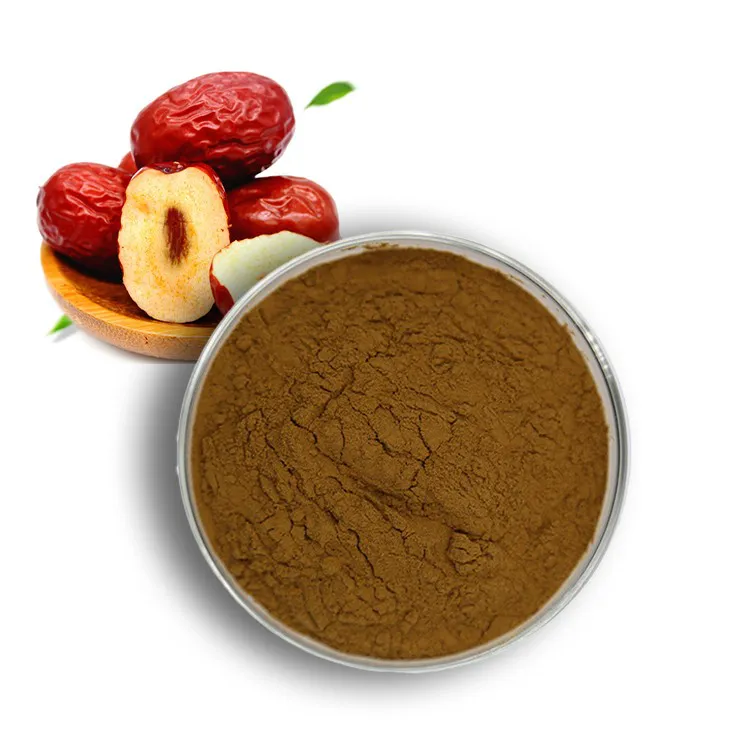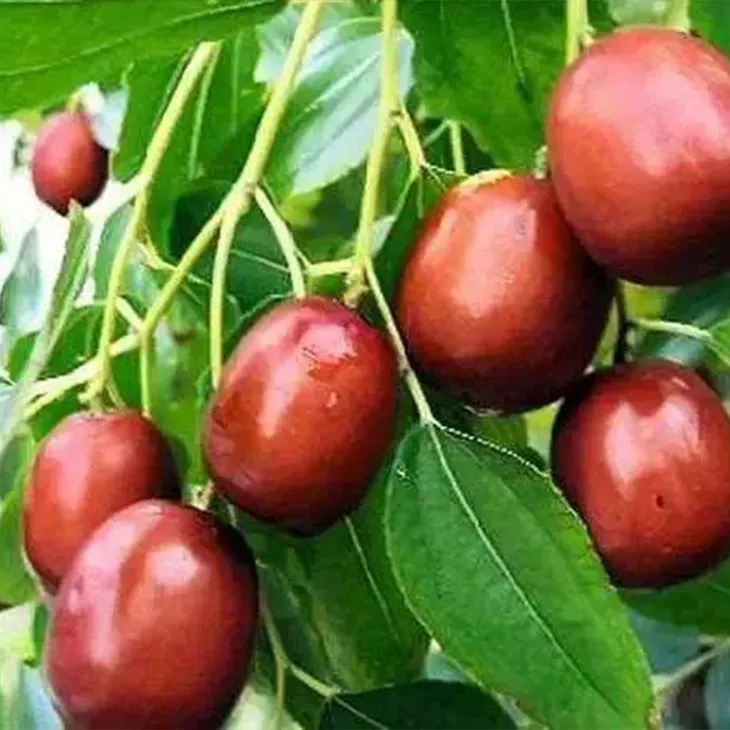- 0086-571-85302990
- [email protected]
The best method for extracting jujube extract.
2024-11-30

1. Introduction
Jujubes, also known as Chinese dates, have been used in traditional medicine and cuisine for centuries. They are rich in various bioactive components such as polysaccharides, flavonoids, and phenolic acids, which possess antioxidant, anti - inflammatory, and immunomodulatory properties. Extracting these beneficial components from jujubes is crucial for their application in the pharmaceutical, food, and cosmetic industries. However, finding the best extraction method is a complex task as it depends on multiple factors including extraction solvents, temperature, and time.

2. Extraction Solvents
2.1. Water
- Water is one of the most commonly used solvents for Jujube Extraction. It is a green and cost - effective option.
- When using water as a solvent, polysaccharides can be effectively extracted. For example, by soaking jujube fruits in water at a certain temperature for a specific time, the water - soluble polysaccharides can dissolve into the water. However, the extraction efficiency of some lipophilic components such as flavonoids may be relatively low.
- The extraction process using water usually requires a relatively long time and a higher temperature. For instance, a temperature of around 80 - 90 °C and an extraction time of 2 - 3 hours may be needed to achieve a satisfactory extraction yield of polysaccharides.
2.2. Ethanol
- Ethanol is another popular solvent for Jujube Extraction. It has good solubility for flavonoids and phenolic acids.
- Ethanol - based extraction can be carried out at different concentrations. For example, a 50 - 70% ethanol solution is often used. At this concentration range, it can effectively extract flavonoids while also having a certain extraction ability for polysaccharides.
- The extraction time and temperature for ethanol extraction also vary. Generally, a lower temperature (around 40 - 60 °C) and a shorter time (1 - 2 hours) may be sufficient compared to water extraction when targeting flavonoids. However, ethanol is a flammable solvent, which requires special safety precautions during the extraction process.
2.3. Mixed Solvents
- Mixed solvents, such as a combination of water and ethanol, can be used to improve the extraction efficiency. For example, a mixture of water and ethanol in a ratio of 1:1 can combine the advantages of both solvents.
- When using a mixed solvent, the extraction can target multiple components simultaneously. The solubility of different components in the mixed solvent may be enhanced, resulting in a higher overall extraction yield. However, the preparation of the mixed solvent needs to be accurate to ensure reproducibility of the extraction results.

3. Temperature
- Temperature plays a crucial role in Jujube Extraction. As mentioned before, different solvents may require different optimal temperatures.
- For water - based extraction, a higher temperature is often needed. However, if the temperature is too high, it may cause the degradation of some bioactive components. For example, when the temperature exceeds 100 °C for a long time, the structure of polysaccharides may be damaged, reducing their biological activity.
- In ethanol - based extraction, a moderate temperature is preferred. Too high a temperature may increase the evaporation rate of ethanol, which not only wastes the solvent but also may pose a safety risk. On the other hand, a too - low temperature may lead to a decrease in the extraction efficiency of flavonoids and other components.

4. Time
- The extraction time also significantly affects the extraction efficiency. A longer extraction time does not always mean a higher yield.
- For water extraction, as the time increases, the extraction of polysaccharides may reach a saturation point. Continuing the extraction beyond this point may not increase the yield but may instead cause the extraction of unwanted impurities. For example, after 3 hours of water extraction at 80 °C, the increase in polysaccharide yield may be negligible, while the amount of other soluble impurities may start to increase.
- In ethanol extraction, a similar situation occurs. After a certain period, the extraction of flavonoids and phenolic acids may reach equilibrium. Extending the extraction time may lead to the extraction of non - target components or the degradation of the target components.

5. Comparison of Different Extraction Methods
- Water extraction:
- Advantages: Green, cost - effective, suitable for large - scale extraction of polysaccharides.
- Disadvantages: Relatively low extraction efficiency for some lipophilic components, long extraction time and high temperature required.
- Ethanol extraction:
- Advantages: Good solubility for flavonoids and phenolic acids, relatively short extraction time and moderate temperature required.
- Disadvantages: Flammable, relatively high cost, may not be as effective for polysaccharide extraction as water.
- Mixed solvent extraction:
- Advantages: Can target multiple components simultaneously, improve overall extraction efficiency.
- Disadvantages: Complex solvent preparation, need to ensure the accuracy of the ratio.
6. Optimization of the Extraction Process
- To optimize the extraction process, a comprehensive consideration of extraction solvents, temperature, and time is necessary.
- For example, if the target is to extract both polysaccharides and flavonoids with high efficiency, a mixed solvent extraction method can be considered. The ratio of water to ethanol in the mixed solvent can be adjusted according to the content of different components in the jujube.
- The temperature and time should also be optimized. Through experimental design, such as response surface methodology, the optimal combination of temperature and time for the mixed solvent extraction can be determined. For instance, it may be found that a temperature of 55 °C and an extraction time of 1.5 hours are the optimal conditions for a certain mixed solvent extraction to achieve the highest yield of both polysaccharides and flavonoids.
7. Conclusion
There is no one - size - fits - all best method for extracting jujube extract. The choice of extraction method depends on the specific target components, the scale of extraction, and cost - effectiveness. However, by carefully considering extraction solvents, temperature, and time, and through optimization of the extraction process, it is possible to maximize the extraction of beneficial components from jujubes for various applications in the pharmaceutical, food, and cosmetic industries.
FAQ:
What are the common solvents used in jujube extract extraction?
Common solvents include water, ethanol, and methanol. Water is a natural and safe solvent, often used in traditional extraction methods. Ethanol is also frequently utilized as it can effectively extract a wide range of active components from jujubes. Methanol, while effective, needs careful handling due to its toxicity.
How does temperature affect the extraction of jujube extract?
Temperature plays a crucial role. Higher temperatures generally increase the solubility of components in the solvent, which can lead to a higher extraction yield. However, if the temperature is too high, it may cause the degradation of some heat - sensitive components. So, an appropriate temperature range needs to be determined based on the nature of the components to be extracted.
What are the main active components in jujube extract?
The main active components in jujube extract include polysaccharides, flavonoids, saponins, and triterpenic acids. Polysaccharides are known for their immunomodulatory effects. Flavonoids possess antioxidant properties. Saponins may have anti - inflammatory effects, and triterpenic acids can exhibit various biological activities such as anti - tumor activity.
How long does the extraction process usually take?
The extraction time can vary widely depending on the method used, the solvent, and the desired extraction yield. For simple water extraction, it may take several hours to overnight. When using more complex solvent systems or advanced extraction techniques like ultrasonic - assisted extraction, the time can be significantly reduced, sometimes to just a few minutes to an hour.
Are there any modern techniques for jujube extract extraction?
Yes, there are several modern techniques. Ultrasonic - assisted extraction is one such method. It uses ultrasonic waves to create cavitation bubbles in the solvent, which helps in the breakdown of cell walls and enhances the extraction efficiency. Another is microwave - assisted extraction, which heats the solvent and sample rapidly using microwaves, reducing the extraction time and often increasing the yield.
Related literature
- “Optimization of Jujube (Ziziphus jujuba Mill.) Fruit Extract by Response Surface Methodology”
- “Comparative Study on Different Extraction Methods of Jujube Polysaccharides”
- “Efficient Extraction of Bioactive Compounds from Jujube Using Supercritical Fluid Extraction”
- ▶ Hesperidin
- ▶ citrus bioflavonoids
- ▶ plant extract
- ▶ lycopene
- ▶ Diosmin
- ▶ Grape seed extract
- ▶ Sea buckthorn Juice Powder
- ▶ Beetroot powder
- ▶ Hops Extract
- ▶ Artichoke Extract
- ▶ Reishi mushroom extract
- ▶ Astaxanthin
- ▶ Green Tea Extract
- ▶ Curcumin Extract
- ▶ Horse Chestnut Extract
- ▶ Other Problems
- ▶ Boswellia Serrata Extract
- ▶ Resveratrol Extract
- ▶ Marigold Extract
- ▶ Grape Leaf Extract
- ▶ blog3
- ▶ blog4
- ▶ blog5
-
The best lemon juice powder in nature.
2024-11-30
-
Organic Vitamin K2 Powder Suppliers
2024-11-30
-
Bulk purchase of L - tyrosine.
2024-11-30
-
Vitamin K2 Manufacturers
2024-11-30
-
100% Pure Natural Rutin.
2024-11-30
-
Chinese Citrus Bioflavonoid Suppliers.
2024-11-30
-
Saponin Extract
2024-11-30
-
Apricot Powder
2024-11-30
-
Cactus Extract
2024-11-30
-
Calendula Extract
2024-11-30
-
Tongkat Ali Extract
2024-11-30
-
Yohimbine Bark Extract
2024-11-30
-
Hesperidin
2024-11-30
-
Garcinia Cambogia Extract
2024-11-30
-
Lotus leaf extract
2024-11-30
-
Rose Hip Extract
2024-11-30





















